The function of guanylate cyclase 1 and guanylate cyclase 2 in rod and cone photoreceptors
- PMID: 17255100
- PMCID: PMC2043484
- DOI: 10.1074/jbc.M610369200
The function of guanylate cyclase 1 and guanylate cyclase 2 in rod and cone photoreceptors
Abstract
Retinal guanylate cyclases 1 and 2 (GC1 and GC2) are responsible for synthesis of cyclic GMP in rods and cones, but their individual contributions to phototransduction are unknown. We report here that the deletion of both GC1 and GC2 rendered rod and cone photoreceptors nonfunctional and unstable. In the rod outer segments of GC double knock-out mice, guanylate cyclase-activating proteins 1 and 2, and cyclic GMP phosphodiesterase were undetectable, although rhodopsin and transducin alpha-subunit were mostly unaffected. Outer segment membranes of GC1-/- and GC double knock-out cones were destabilized and devoid of cone transducin (alpha- and gamma-subunits), cone phosphodiesterase, and G protein-coupled receptor kinase 1, whereas cone pigments were present at reduced levels. Real time reverse transcription-PCR analyses demonstrated normal RNA transcript levels for the down-regulated proteins, indicating that down-regulation is posttranslational. We interpret these results to demonstrate an intrinsic requirement of GCs for stability and/or transport of a set of membrane-associated phototransduction proteins.
Figures
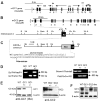
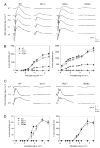
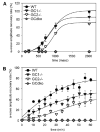
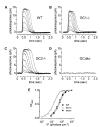
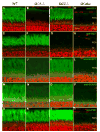
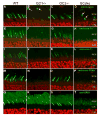
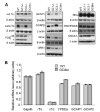
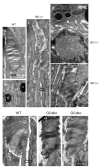
Similar articles
-
A model for transport of membrane-associated phototransduction polypeptides in rod and cone photoreceptor inner segments.Vision Res. 2008 Feb;48(3):442-52. doi: 10.1016/j.visres.2007.08.020. Epub 2007 Oct 18. Vision Res. 2008. PMID: 17949773 Free PMC article. Review.
-
GC1 deletion prevents light-dependent arrestin translocation in mouse cone photoreceptor cells.Invest Ophthalmol Vis Sci. 2005 Jan;46(1):12-6. doi: 10.1167/iovs.04-0691. Invest Ophthalmol Vis Sci. 2005. PMID: 15623748
-
Cone cell survival and downregulation of GCAP1 protein in the retinas of GC1 knockout mice.Invest Ophthalmol Vis Sci. 2004 Oct;45(10):3397-403. doi: 10.1167/iovs.04-0392. Invest Ophthalmol Vis Sci. 2004. PMID: 15452041
-
Modes of Accessing Bicarbonate for the Regulation of Membrane Guanylate Cyclase (ROS-GC) in Retinal Rods and Cones.eNeuro. 2019 Feb 15;6(1):ENEURO.0393-18.2019. doi: 10.1523/ENEURO.0393-18.2019. eCollection 2019 Jan-Feb. eNeuro. 2019. PMID: 30783616 Free PMC article.
-
Tuning outer segment Ca2+ homeostasis to phototransduction in rods and cones.Adv Exp Med Biol. 2002;514:179-203. doi: 10.1007/978-1-4615-0121-3_11. Adv Exp Med Biol. 2002. PMID: 12596922 Review.
Cited by
-
Structural basis of retinal membrane guanylate cyclase regulation by GCAP1 and RD3.Front Mol Neurosci. 2022 Sep 8;15:988142. doi: 10.3389/fnmol.2022.988142. eCollection 2022. Front Mol Neurosci. 2022. PMID: 36157073 Free PMC article. Review.
-
Structural view of G protein-coupled receptor signaling in the retinal rod outer segment.Trends Biochem Sci. 2023 Feb;48(2):172-186. doi: 10.1016/j.tibs.2022.08.010. Epub 2022 Sep 23. Trends Biochem Sci. 2023. PMID: 36163145 Free PMC article. Review.
-
ROS-GC interlocked Ca(2+)-sensor S100B protein signaling in cone photoreceptors: review.Front Mol Neurosci. 2014 Mar 26;7:21. doi: 10.3389/fnmol.2014.00021. eCollection 2014. Front Mol Neurosci. 2014. PMID: 24723847 Free PMC article. Review.
-
Genetic manipulation of rod-cone differences in mouse retina.PLoS One. 2024 May 6;19(5):e0300584. doi: 10.1371/journal.pone.0300584. eCollection 2024. PLoS One. 2024. PMID: 38709779 Free PMC article.
-
Interaction of retinal guanylate cyclase with the alpha subunit of transducin: potential role in transducin localization.Biochem J. 2009 Feb 1;417(3):803-12. doi: 10.1042/BJ20081513. Biochem J. 2009. PMID: 18840097 Free PMC article.
References
Publication types
MeSH terms
Substances
Grants and funding
- R01 EY006837/EY/NEI NIH HHS/United States
- R01 EY009339/EY/NEI NIH HHS/United States
- P30 EY011373/EY/NEI NIH HHS/United States
- EY08123/EY/NEI NIH HHS/United States
- R01 EY014596/EY/NEI NIH HHS/United States
- R37 EY006837/EY/NEI NIH HHS/United States
- EY06837/EY/NEI NIH HHS/United States
- F32 EY006837/EY/NEI NIH HHS/United States
- R01 EY008123/EY/NEI NIH HHS/United States
- P30 EY014800/EY/NEI NIH HHS/United States
- R01 DC006904/DC/NIDCD NIH HHS/United States
- EY09339/EY/NEI NIH HHS/United States
- P30 EY11373/EY/NEI NIH HHS/United States
LinkOut - more resources
Full Text Sources
Other Literature Sources
Molecular Biology Databases
Miscellaneous

